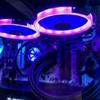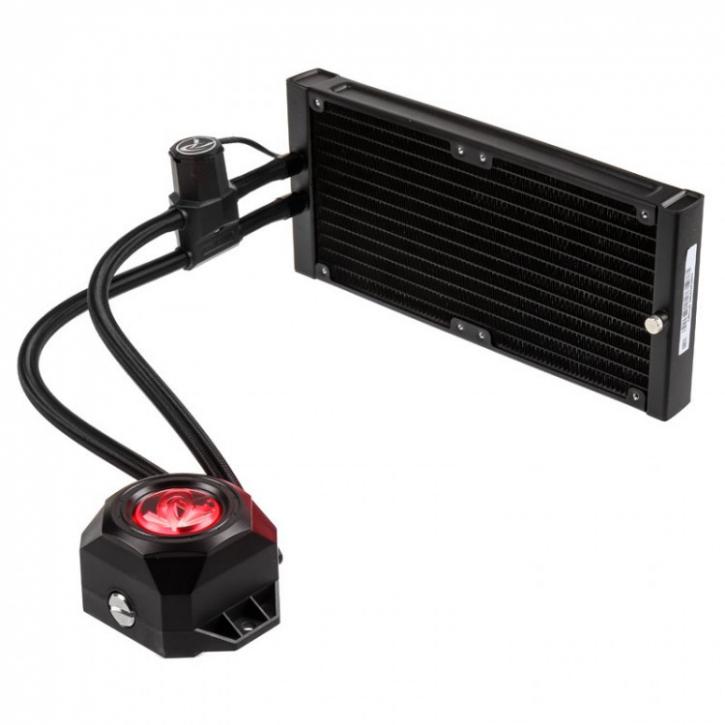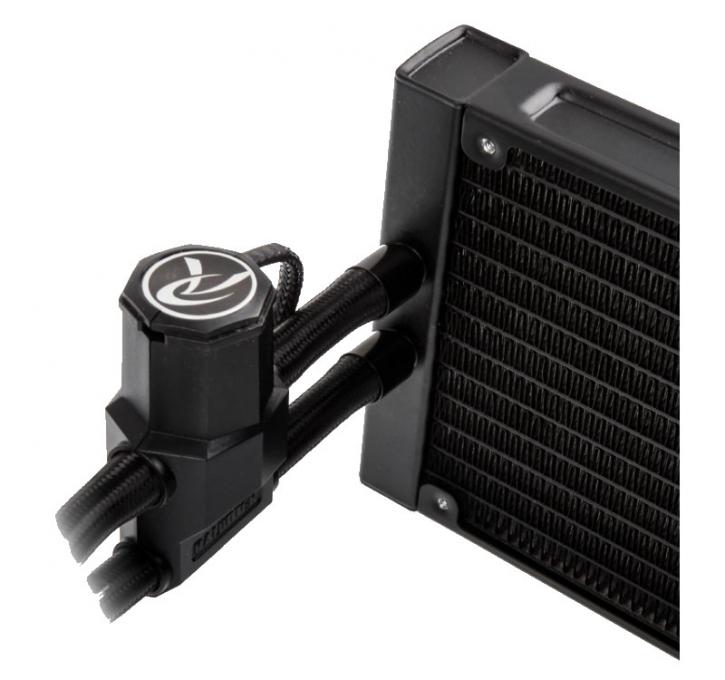The all important numbers
Features
If the Celsius S24 was both very austere and plain in its design aesthetic, then Raijintek have evidently thrown absolute caution to the winds here. Shall we take a look at the visual checklist? Fan and block RGB? Check. Wacky and entirely OTT pump head? Check. Integrated flow meter that also lights up? Check. Integrated RGB controller with additional remote control? That's also a check. The unit is going to be top mounted in my Corsair 275R case, thereby allowing the full effect of the lightshow to be visible at all time, even though the PC is under my desk. First up, shall we rattle off what Raijintek have to say about the unit? For the record, the below is a direct copy/paste from Raijintek's site, with no editing done by me. I think it's safe to say that Raijintek maybe needs to proofread their product blurbs a little more? For the record, Raijintek do not have a dedicated product page for their Core edition. I find this to be a little odd, I have to say. The below is, therefore, taken directly from the full edition of the Orcus. Take and leave what bits apply to whatever product you may end up buying.
- Best performing, most user friendly and most spot light catch , an AIO liquid cooling system at market.
- All-In-One liquid CPU cooler with external PUMP, copper Water block and Rotating Blade with RGB light.
- New design and External Pump with high Q-max (66 L/H) and no vibration incurred on M/B and CPU.
- Durable and reliable PUMP Bearing type - Ceramic axis.
- Copper water block by microchannel, extra large contact fin area with multiple channels to provide best flow of liquid.
- Cooling fan system with 12025 RGB PWM fans, 8 port control hub and remote controller.
- 8port Control hub with switch of "M/B ; Remote" to provide most usage of RGB lighting control.
- Rotating Blade design with RGB LED inside tank to show water flow and indicates the coolant level.
- 2pcs performing 12025 PWM fans with RGB lighting.
- Specific 11 fan blade design and 8pcs Anti-vibration rubbers.
- Refillable and high capacity coolants pre-filled design.
- 240mm high density fin radiator with 12 channels.
- Solid mounting kits to provide sturdy installation.
- Mesh tube with low evaporation rate.
- Multiple mounting kits for modern sockets of INTEL & AMD CPU.
With that out of the way, let's look at the specs. Naturally, if there are any differences between the Regular and Core editions of this product, I will list them, but I was unable to find any in my research around the two.
Specifications
Getting down to the nitty gritty of what this unit packs under the hood, first up, the radiator. It's a 27mm thick (putting it 4mm shy of the radiator on the Celsius), and is made of aluminium. Raijintek advertises the rad to be of a 'high fin density,' which essentially refers to how tightly packed the fins on the radiator are. The higher this number, providing the fans have sufficient pressure to push air through, the better the cooling potential of the radiator. The actual figure is not clearly advertised, sadly, which I find to be a little 'off,' for lack of a better word. To my mind, this only raises an eyebrow to the fact that the FPI rating might not be as high as it should be? Naturally, I cannot draw conclusions yet, and we will have to wait till later to see whether this unit can walk the walk with other AIOs in a similar price bracket.
What about tubing? Well, for a start, it's braided. There is no reason to be using non-braided or sleeved tubing in 2018. The diameter measures in at 10.6mm OD, and 5mm ID (Outer and Inner Diameter, respectively). This certainly puts in on the skinny side, but I do not consider this to be a problem, given commonly accepted thoughts about AIO's, the pumps used, and even a recent video from Linus Media Group on this very issue. If you're interested, I will link here. If you want the short version, tubing width has near zero effect on temps. The Orcus will, therefore, be fine with 5mm tubing. Pump wise, we're able to reach 5,000rpm (as opposed to the S24's 3150rpm, if you wish for a comparison). The S24's pump tops out at a mere 20dBa, however, whereas the Orcus' is a full 5dBa higher. Since the decibel scale is non-linear, an increase of as low as 3dBa is might well be noticeable to the human ear, so 5dBa will certainly be picked up on. Playing Devil's Advocate for a moment here, however, I think it's reasonable to say that most people using this unit are going to have the sound of their game overpowering the pump, and if the pump is working at the full tilt of 5000rpm... maybe turn down that overclock? Finally, the lifespan is good, at 50,000 hours. With that said and done, a faster pump will certainly help to circulate the water around the loop faster. This should only be a factor, realistically speaking, during initial testing. This is because water takes a lot longer to 'saturate' (in terms of equalizing temperature) than air does, so air coolers tend to 'peak' in temperature much quicker.
Now, the fans. Naturally, this segment is only really relevant to the full edition of the cooler. Core edition adopters will be using their own supplied spinners. Anyway. Arguably the visual and performance centerpiece of this unit, and any AIO/tower, bad fans still mean a bad cooler, no matter the looks. How do they stack up against the GP-12's on the S24? Well, they are both 4-pin PWM controlled units, meaning that their speed can be user controlled in increments significantly finer than what can be done on 3-pin DC controlled units. That is where the similarities end, however. These fans are VERY different, to the point of being a little unbelievable. Therefore, some numbers for you.
- Airflow: 42.17 (Raijintek) vs. 87.6 CFM (Fractal).
- Pressure: 1.7mm vs. 2.3mm H20.
- Noise: 25dBa vs. 35dBa
- Speed: 800-1800rpm vs. 800-2000rpm
On paper, pure performance wise (because whilst important, noise is not going to affect how your cooler performs), the GP-12's supplied with Fractal's S24 seem to win absolutely hands down. However, I do not think this is the end of the story, and we will have to wait till' later to see what happens. At this point, I have not done performance testing, so your guess is as good as mine. With the numbers out of the way, shall we unbox it?



